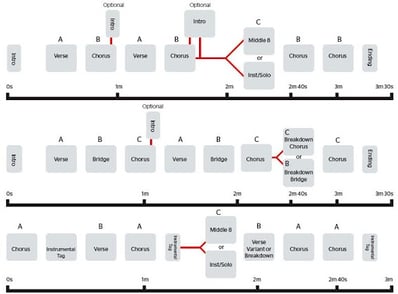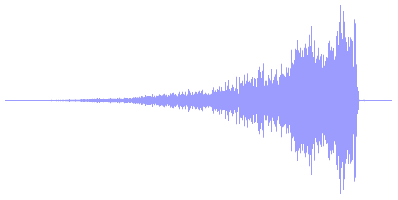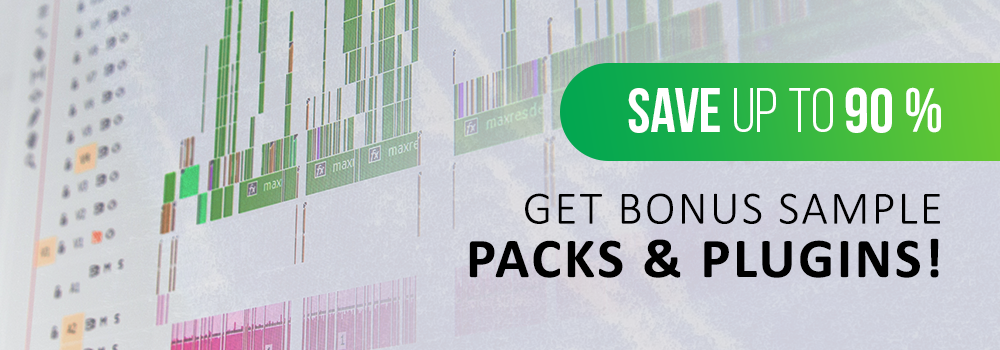Now there isn't always a cut and dry way to arrange a piece of music. Unless you're working to picture or an already written piece of sheet music, arranging your song is completely up to you. Having distinct separation and an all-around flow to your song is a crucial step in the production process. How a song flows is a completely personal creative choice, but over the years producers have noticed patterns specific to certain genres. These patterns can be helpful guidelines to help you develop your own creative flow in musical arrangement.
Overall Song Structure

Over the years popular music has seen a large shift in the length of songs decreasing 20 seconds in the last 5 years alone. The average song length as of today is nearly less than three and a half minutes. Now not everyone will want to create music in that range some producers may want 4-5 minute songs with longer verses and choruses, others may want to create 10-minute long rock ballads. Whatever your musical preference it's important to keep a song interesting.
Phrasing

Phrasing is a musical term of variation. Meaning certain melodies, lyrics, or even synthesized sounds playing in an order that follows a pattern of call and response. For example, The sound design of a drop could change in an ABAC pattern. This means that A is the same call each time it's played. Either a synth, bass, or melody. The B and C portions are two different response variations of a different element of music. This creates a unique pattern that adds flavor and substance to your track.
Transitions

Having strong transition elements can keep a listener interested and entertained while switching from verse to chorus & chorus to verse. Adding impacts, reversed sounds, specific vocal phrases, or even taking elements of the song away can all change the flow. This can add effect and take your song into its next section without disrupting the song itself. An important phrase to remember is “Don't bore us, get to the chorus”. Keeping the sections of your song 8 – 16 bars (however this is not a rule) can help you maintain a strong flow within your track.
Sections Of A Song
Here are a few formats of popular genres in music.
EDM: Intro – Break (or Verse) – Buildup – Drop - Break (or Verse) – Buildup – Drop – Outro
Known also as the Golden Gate formula the emphasis of the song is put into the buildup and drop.
Pop: Intro – Verse – Chorus - Verse – Chorus – Bridge – Chorus
Pop songs are usually structured to emphasize the chorus. Typically getting there as quickly as possible with a strong motif.
Beats or Hip-Hop: Intro – Verse – Hook – Verse – Hook – Verse – Hook x2 – Outro
Allowing for more freedom within the verses and hooks. Beats usually let the vocalist speak freely within the verses and have some emphasis on the chorus or hook, but not nearly as much as pop.
Instrumentation

Instrumentation in short means knowing where certain elements of a song belong. For example, you wouldn't want to have more than two guitars on a record playing at the same time. The frequencies would clash and although it would sound cool in a live setting, would make for a muddy mix later on. This is important to understand for the little things in a song like strings. If you're using a sampled library or synthesized strings, having those strings play notes that a live instrument couldn't, might sound unnatural and could affect the sound of your mix. If you're recording a vocalist, make sure to give them room to be heard, having a crazy synth or instrument playing at the same time could lessen the impact of those vocals.
Trap, Hip-hop & Beats

Producing a solid beat isn't just as simple as 808s and a loop. There is a certain style that exists within beat production that makes something stand out. A symbiotic relationship exists between a solid lyricist and an interesting instrumental.
Intro
A successful beat will begin with an interesting introduction. Something that catches the ear without overshadowing potential vocals. If the goal is to get a vocalist on the track, it's important to keep the elements of the beat simple yet effective. Too many melodic elements or sounds can crowd the artist's voice and distract from the lyrics.
Verse
Keeping simplicity in mind while writing a verse, you want to focus on your sample selection and leaving room for a vocalist. On the other hand, if you're producing something purely to be an instrumental, then having more melodic elements can absolutely take the place of vocals. The verse should flow well and ride the beat. Try to not add too many elements to change the energy and build-up to the chorus. Instead of a strong buildup into the hook, have to flow naturally, then add more elements as you transition into the hook of the song.
Motif
A motif is a short musical phrase that reoccurs within a piece of music. This is where a loop, or melody would come into play. Sample selection is a huge portion of making any beat stand out. A recognizable phrase in a song that will catch the ear of a listener. Something that can identify a song even within the first few seconds of the track. This can be a sampled loop, a guitar phrase, or even a piano.
Hook
The motif of a song can also be translated into the hook. This particular motif in a song can exist either throughout the song entirely or in the chorus alone. For example the hook of the October 13th, 1999 Classic Still Dre (feat Snoop Dogg):
“I'm representin' for them gangstas all across the world
(Still) Hittin' them corners in them low-lows, girl
Still takin' my time to perfect the beat
And I still got love for the streets, it's the D.R.E”
The hook of the song not only gives you its message clearly, but it also lets you know that Dre is, indeed taking his time to perfect the beat.
Pop Music

Since the late 2010s rap and pop music have almost completely interchanged. Having similar song structures, you can use the same methods of arranging a hip-hop record as you would a pop record. There are strong differences between the two, especially the emphasis on the chorus.
Verse
Even though a very important part of pop arrangement is the chorus, the verse still has a lot of weight to it. You can set of motifs, tease a melody from the chorus, or play with the pacing of a song before opening it up in the chorus. Usually, around the same length as your chorus, you can have more of a buildup to create that push and pull tension between the verse and the chorus.
Chorus
The chorus of a pop record is everything. Getting there as quickly as possible in a song without rushing a verse is a technique to practice. Some producers and artists won't even write the first verse. They might go straight from the intro to the first chorus to sell that impact. The chorus is where everything explodes, the vocals are at their peak performance, the instruments are interesting and wide, and the drums are smacking. Keep in mind that the chorus can still be reasonably short 8 – 16 bars or 20 seconds. This can leave the listener wanting more and interested for the rest of the song.
Working With The Lyrics
Pop music not only emphasizes the song itself but the lyrics of particularly the chorus. Strong songwriters will not only create a memorable and powerful, but a supporting verse as well. A strong producer can even play around with the pacing of the song to emphasize certain phrases or lyrics. A perfect example of this is “Bury A Friend” by Billie Eilish. Her producer and brother Finneas O'Connell really plays with the energy of the song around her lyrics. Stopping certain sections or adding some unique form of sound design to add emphasis to the words.
Edm Structure

The term EDM has been used quite frequently over the years and might be associated with a stereotypical form of song structure. However, when you dive deeper into the arrangement styles of many producers you can find so many different stylistic choices when it comes to the arrangement.
INTRO
Keeping your intro short can be hard in a lot of electronic music. We all like to set an ambiance or keep the kick rocking. Keeping an intro short has the same effect as it does in pop music (or any other genre in for that matter). We want to get to the good stuff. Having an equal 8-16 bars for your intro can keep it effective without sacrificing your creative vision.
The Buildup
We all love a good drop. The part of a song where everything comes together, but what about the buildup. Over the years we've seen a lot of the same buildups, risers, and drum patterns to get to where we want to go. Certain genres like techno or minimal house have taken this buildup method and have done it more subtly. Foregoing the more intense drums or effects and instead, taking elements out only to bring them back in at the right moment to give the audience that rush of energy. If you make a more aggressive form of electronic music using subtlety in your builds can also create a better tension within your track. Removing drums at the right time or even adding an isolated vocal sample right before a drop can really add to the overall pace of a song. We all know the drop of a song has to be solid, but paying close attention to how we get there can set that song up for success.
The Drop
Similar to a chorus this is where everything comes together. The drop of a song is also its motif, even if there aren't lyrics people will remember its sound design or melody. When creating the arrangement for your song try and add or replace certain elements in the drop. Each drop doesn't have to be completely different. Try changing the sound of a melody or the sound design on a particular bass. Even subtle changes like adding or removing drums can give the drop a different effect. It's also important that creating intensity doesn't always mean having a wall of sound. Simple drops with a few elements can bring all the energy you need for your song. Keep it simple!

















_Cropped.png?width=1600&name=02%20(2)_Cropped.png)




















Your Comments :